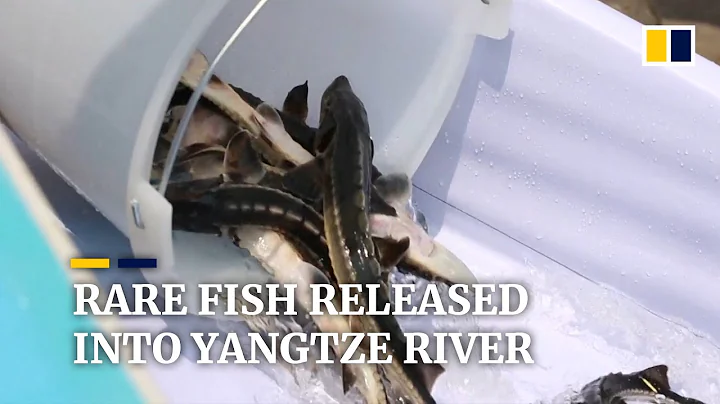"People live up to the green mountains, and green mountains will never live up to people." This sentence is also aptly applied to the Yangtze River. The Yangtze River is one of the seven rivers with the highest biodiversity . With more than 4,300 biological species, it can be called an "ecological treasure house". Starting from 2021, the Yangtze River ecology will enter a comprehensive restoration period, and ecological benefits are emerging.

Speaking of the ecological restoration results of the Yangtze River, we have to mention the four major fish. They are known as " domestic fish ", which shows that these four kinds of fish have high production (total production exceeds 11 million tons), are widely distributed, and have a huge impact on people's lives. The four major species of fish are the dominant fish species in the Yangtze River. Since the fishing ban, fish schools have frequently appeared on the river, and a "beautiful scenery" has appeared in the Wanzhou section.

Fortunately, the spawning volume of Yangtze river fish has also hit a record high recently! In the Yidu River section, scientific researchers estimated that the total number of fish spawning was 15.3 billion, of which the contribution of four domestic fish eggs was 8.8 billion, setting a new record for the scale of spawning.
What are the four major fishes? How to monitor egg production?
The four major fish species are actually herring , grass carp, silver carp, and bighead carp. They are all indigenous fish in the Yangtze River Basin. They are favored by fishermen and markets because of their large size, beautiful meat quality, and high yield. In the 1970s, the fishery industry in the middle reaches of the Yangtze River was prosperous. The four major species of fish accounted for about 30% of the catch, making them truly the dominant fish.

Herring is the only carnivorous fish among domestic fish, with inactive habits. It often lives at the bottom of rivers and lakes, foraging for snails, river mussels and other shellfish; grass carp has active habits, has a slender body, feeds on grass and They have a huge appetite and have the habit of foraging in groups. silver carp and bighead carp are active in the upper layer of the water body. The former has active habits and strong jumping ability, and feeds on phytoplankton ; the latter has docile habits and does not like jumping and feeds on zooplankton.

Although the four major fish species have different living habits and different habitats in the water layers, they all have a common characteristic, that is, the same reproduction method: they all need to migrate through rivers and lakes to successfully lay eggs, and the egg types are all drifting eggs.
The surface of drifting eggs is not sticky. When it comes into contact with river water, it absorbs water and swells. Its specific gravity is slightly larger than water. Therefore, it is easy to sink in a still water environment, eventually leading to hypoxia and necrosis of fish eggs. Only in waters with deep and fast currents can the eggs float on the surface of the river and drift with the current. Research shows that the flow velocity range of domestic fish when spawning is 0.33~1.50m/s, and as long as the water flow velocity is higher than 0.25m/s, fish eggs will not sink. Therefore, the conditions of the spawning ground can ensure the safe drift of fish eggs.

So, how are the eggs of fishes monitored? Of course, the 8.8 billion fish eggs are certainly not counted one by one, but are the result of statistics and estimation. On biostatistics , there are many methods for counting fish eggs, such as: direct points, area method, volume method, weighing method, etc.

Since the eggs of the four major species of fish are all drifting eggs, the eggs occupy a certain area on the river surface when flowing. Therefore, a dense mesh screen can be used to filter the eggs, and the statistical results can be used as samples to estimate the overall spawning volume. In actual surveys, other more advanced and scientific monitoring methods can also be used to reduce statistical errors in a variety of ways.
The four major fish species: dual crises of resources and spawning volume
Traditional fishermen have the most say whether there are more or less of the four major fish species in the Yangtze River. According to a fisherman surnamed Li from Gong'an County, Hubei Province, he has been fishing with his father in the Yangtze River since he was 18 years old. In the 1990s, there were many of the four major fish species in the Yangtze River. One net could catch 4 to 5 kilograms of fish. They are not small in size and have abundant resources.

In the first few years when I was fishing to make a living, the average catch per day was more than 50 kilograms, and a cabin could be caught in one morning. Among them, silver carp and grass carp were the most abundant, and black carp could also be caught frequently. In the afternoon, these fish are taken to the market for sale. Because they are wild fish caught from the Yangtze River, they are very popular in the fish market.
Since 2002, wild domestic fish resources have been significantly reduced, and their sizes have become smaller and smaller. It often takes 2 to 3 days to catch a fish weighing 2 pounds.Bighead carp, which is very popular among consumers, is rarely seen in resource-rich river sections. Even old fishermen lamented helplessly: "The number of domestic fish in the Yangtze River is estimated to have decreased by 2/3."

In 2018, CCTV media released a news report that "the four major domestic fish species have suffered a loss of more than 90%, and the aquatic life resources of the Yangtze River have declined." This has attracted great attention from all walks of life, indicating that the domestic fish resources in the Yangtze River are on the verge of depletion.

First of all, let’s look at the amount of resources and fishing volume. Compared with the 1980s, the number of domestic fish resources in the Yangtze River decreased by more than 90% in 2018, and the magnitude of the change is shocking. The catch in the main stream of the Yangtze River has also dropped from 6.427 million tons of fish in 1954 to less than 6.1 million tons of fish in 2020. The four wild species of fish have borne the brunt, and the reduction in production has been particularly obvious.

Secondly, the hatching volume of fry has also been greatly reduced. May to July every year is the main breeding period for domestic fish in the Yangtze River. Institutions such as the Institute of Fisheries of the Chinese Academy of Sciences will conduct cross-section collection along the river at the same time and place. According to statistical results, the average runoff of domestic fish eggs in the 1990s was as high as 62.5 billion ; from 2002 to 2011, it dropped to a historical low, and the total runoff of larval fish in many years was less than 100 million .
Therefore, the four major fish species in the Yangtze River are facing dual crises of resources and reproduction.
The main reason is that the construction of hydropower stations in the middle reaches of the Yangtze River has changed the shape and flow characteristics of the downstream rivers, destroyed spawning grounds and habitats, and resulted in serious resource decline. In addition, illegal fishing, water pollution, excessive sand mining, etc. have also contributed to the situation and accelerated the process of resource decline.
Three Gorges Reservoir : After 12 years of ecological regulation, domestic fish spawning has increased 44 times
Since fishing was banned in the Yangtze River, the reserves of the four major species of fish have increased. The provinces and cities along the river have released flows in units of hundreds of millions, and the restoration results have been remarkable. In the Zhenjiang section of the Yangtze River, fishery officials also took pictures of a scene of "silver carp frying in the water" during their inspection. Hundreds of silver carp weighing three to five kilograms jumped out of the water due to being disturbed. The scene was very lively and lively.

The number of wild domestic fish in the Yangtze River is increasing rapidly, but protecting domestic fish cannot only rely on releasing fry, but more importantly, expanding the scale of natural reproduction.
Why should we emphasize natural reproduction? Because the four major species of fish spawn huge amounts, the effect of natural reproduction is more significant than artificial release. Take silver carp as an example. A silver carp matures in 3 to 5 years and can carry 200,000 to 1.61 million eggs. It can reproduce for 2 to 3 generations after a 10-year ban on fishing, and the mature population will exceed five age groups. If properly protected, fish stocks will most likely experience "explosive growth".
Therefore, the option of natural reproduction is better than artificial release. In this regard, the Three Gorges Reservoir has played an irreplaceable role: shaping "artificial flood peaks".

Before 2011, the dispatching of the Three Gorges Reservoir was relatively monotonous, focusing on flood control dispatching. In 2011, ecological dispatching experiments began. What is ecological dispatch? It is to scientifically release water during the breeding period of domestic fish to create an "artificial flood peak" in the middle and lower reaches of the Yangtze River, causing the main stream of the Yangtze River to rise, which is crucial to the natural reproduction of domestic fish.
As the water rises, the Yangtze River will experience changes such as rising water levels, increased flow, and reduced transparency, which will stimulate the gonads of domestic fish. According to the observation of fishery science and technology personnel, domestic fish in the lower reaches of the Yangtze River begin to spawn intensively about 0.5 to 2 days after the Yangtze River rises. Moreover, the longer the water rise process, the greater the amount of eggs laid. There is a significant positive correlation between the two.

In addition, ecological dispatch also meets the water temperature requirements for domestic fish reproduction. The Three Gorges Reservoir has a "thermal lag effect", but from May to July, the water temperature under the dam is already higher than 18°C, and can reach 25°C in July. The optimal water temperature for domestic fish to spawn is 18~24℃, and the optimal temperature for embryo hatching is 18~30℃, so 18℃ is the lower limit temperature for domestic fish reproduction. The ecological management of the Three Gorges Reservoir from May to July is beneficial and harmless to the reproduction of domestic fish.

Based on the above two points, the flood peak formed by ecological dispatch plays a role in artificially stimulating labor, and the effect is indeed significant.Let’s compare another set of data: In 2011, the number of domestic fish spawning in the Yidu section of the Yangtze River was less than 200 million. In 2022, it increased to 8.8 billion, a 44-fold increase in 12 years. The effect is incredible. Significantly.
Summary
The ban on fishing in the Yangtze River protects not only fish, but also the ecological environment of the Yangtze River. As the "gene bank of aquatic life", the water environment of the Yangtze River is related to the ecological well-being of future generations. The implementation of a fishing ban is a good thing that will benefit the future. The ecological regulation of the Three Gorges Reservoir is also a positive and beneficial attempt.
Biological resources are restored and domestic fish spawning reaches a new high. We are witnessing the ecological changes of the Yangtze River.





















